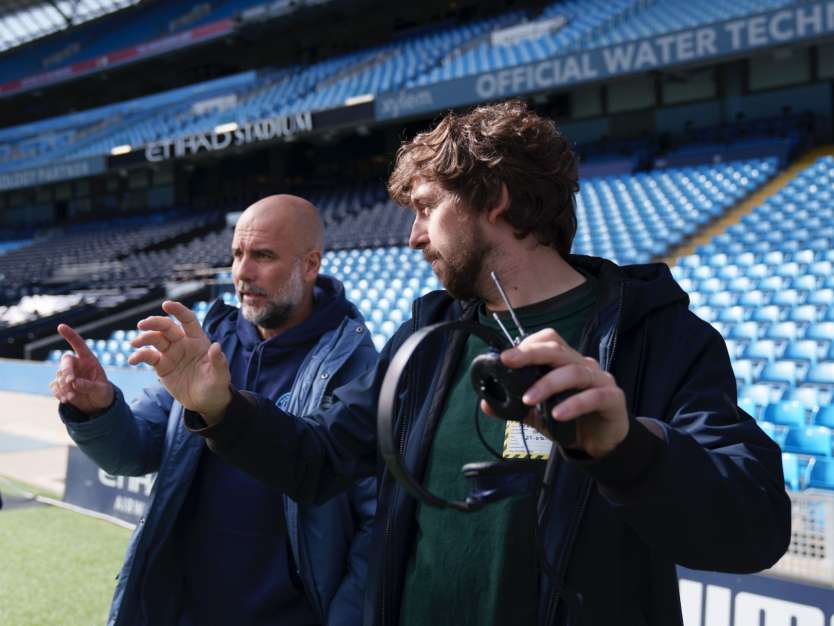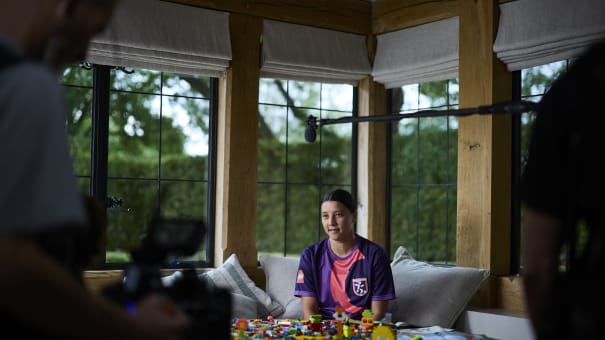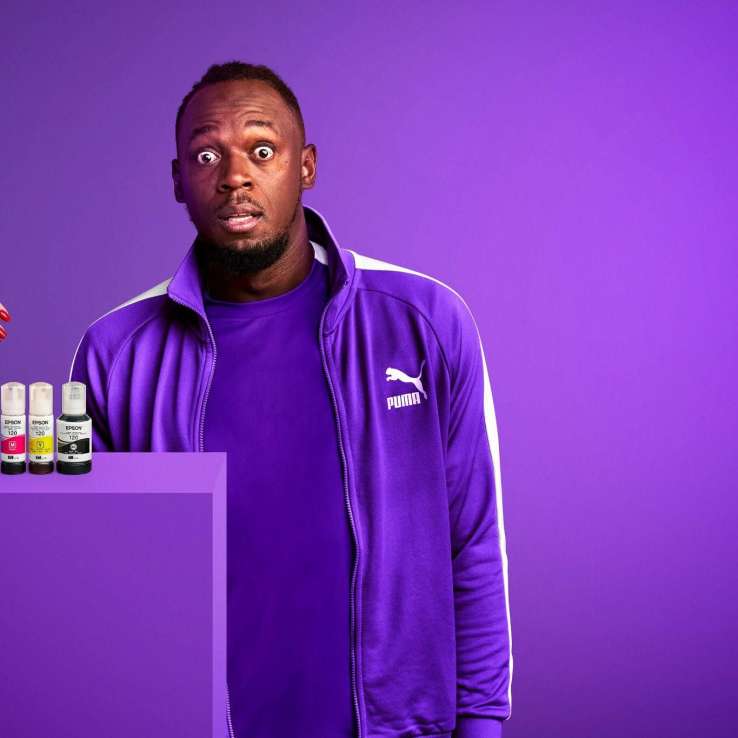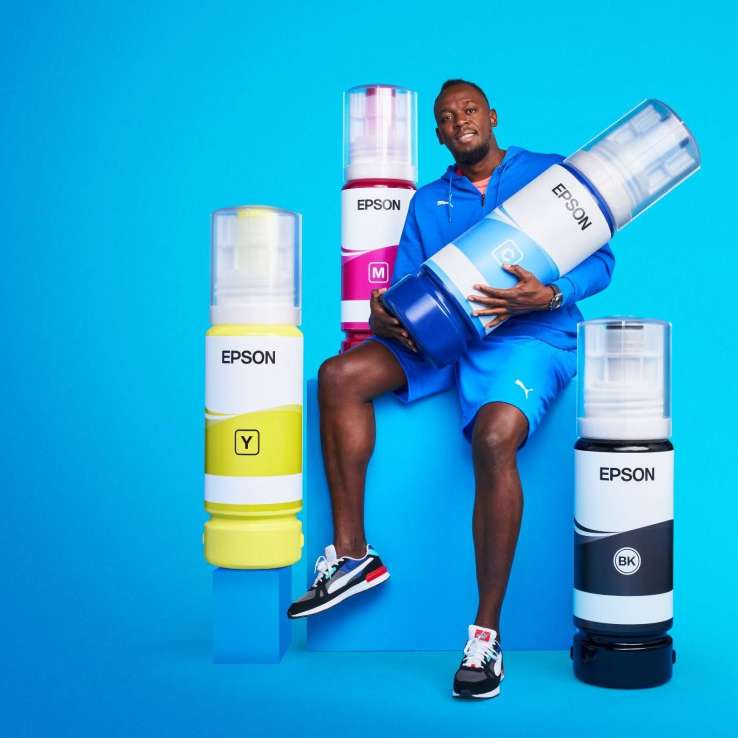
SPORTFIVE's Production Studios: Where Sport Meets Content
Published on
by Izzy Fawcett
In an era where captivating content drives engagement, SPORTFIVE’s in-house production department delivers powerful storytelling through high-quality creative production.
Born from decades of experience in sports marketing, this department was established to meet the growing demand for content that goes beyond traditional sponsorship, crafting emotionally impactful stories that connect brands, fans, and athletes across platforms.
In this Insight:
The Story Behind The Studio
SPORTFIVE’s in-house production department is responsible for delivering meaningful creative solutions through story-focused outputs. With decades of experience connecting brands, rightsholders, and fans, SPORTFIVE recognised the need for high-quality, tailored content that goes beyond traditional sponsorship activations.
To meet this demand, our dedicated Production Studios were established, specialising in crafting compelling visuals and stories that resonate across platforms. From international sporting events to brand-led campaigns, our team has become a trusted partner for innovative, impactful storytelling.
In the below article, we explore how our team of experts carefully work with both brands and rightsholders to deliver first-in-class services, including creative conceptulisation, film production, still production and post production.
LIGHTS, CAMERA, ACTION!

Creative Conceptualisation
Every successful production begins with a powerful idea. At our in-house Production Studio, the team works closely with clients to understand their brand, objectives, and target audiences.
This stage is about more than just brainstorming - it’s about translating brand values into authentic creative concepts that capture attention and spark engagement.
Whether it’s developing a narrative around an athlete, shaping a visual identity for a campaign, or aligning with the energy of a live sporting moment, conceptualisation ensures every project has a strong foundation.
From placing Pep Guardiola waist-deep in unfiltered wastewater for the emotive film that spearheaded Xylem and Manchester City's ‘Take The Waste Out Of Water’ campaign, to capturing the real moments behind Bukayo Saka and Fiverr's partnership to inspire people of diverse backgrounds to pursue their dreams.
SPORTFIVE's Production Studios Services
Film Production
With expertise in sports and lifestyle content, our in-house Production Studios excels in film production. The team manages the entire process, from scripting and storyboarding to directing and on-site shooting.
This work has seen the team deliver compelling films for clients from a multitude of industries and across a range of content types. From creating engaging TV commercials for leading consumer brands such as LEGO, JD and Pandora, crafting social-first athlete-centred content with James Maddison and Katie Boulter, to capturing compelling value-driven films to centre campaigns around for Xylem and Manchester City.
Whether it’s commercials, social-first content, performance marketing assets or behind-the-scenes footage, our team's film production combines technical precision with an emotional touch.
Leveraging access to global sporting talent and iconic venues, this department captures the action in ways that bring audiences closer to the heart of sport.

Still Production
In a fast-moving digital world, striking imagery remains a cornerstone of communication. Our in-house Production Studios delivers high-quality still photography for campaigns, press materials, and brand activations.
Our photographers are skilled at capturing both the intensity of live moments and the artistry of staged shoots, ensuring every image speaks volumes. With an eye for detail and creativity, still production creates assets that are versatile, shareable, and timeless.
Our recent work with printing specialists Epson showed just how gripping carefully curated still imagery can be. Our team managed to catch up with the world's fastest man, and Epson ambassador Usain Bolt to capture pictures that showed the captivating qualities of true colour.
Epson x Usain Bolt 'Just Fill & Chill' Campaign




Post Production
The final stage of the process is where everything comes together. Our team's post-production services include editing, colour grading, sound design, and motion graphics, ensuring that each project is polished to perfection.
With a deep understanding of distribution channels - whether broadcast, digital, or social - content is optimised to perform across platforms. Post-production is where raw footage transforms into compelling stories that inspire, entertain, and engage audiences worldwide.
In today’s sports and entertainment landscape, content is king. This department stands at the forefront, offering brands and partners a full-service production journey - from the spark of an idea to the final polished asset.
With creativity, expertise, and a deep connection to the world of sport, we don’t just produce content - we create experiences that last far beyond the final whistle.
Frequently Asked Questions
Partnership marketing, also known as strategic collaboration, is a mutually beneficial arrangement where two or more businesses or entities join forces to achieve shared marketing objectives.
In this approach, each partner contributes resources, such as customer base, expertise, or promotional channels, to create a synergy that enhances the overall effectiveness of the marketing efforts.
The collaboration can take various forms, including joint promotions, co-branded products, shared events, or cross-promotional campaigns.
Partnership marketing enables companies to reach new audiences, increase brand visibility, and capitalise on the strengths of their partners. It fosters a win-win scenario, where both parties leverage the relationship to achieve strategic goals and often results in a more cost-effective and impactful marketing strategy for all involved.
A sports sponsorship campaign is a strategic marketing initiative where a brand aligns itself with a sports property, team, event, or athlete to achieve specific marketing objectives. Here's an overview of what a sports sponsorship campaign typically involves:
Objective Definition: Clearly define the goals and objectives of the sponsorship campaign. This could include increasing brand awareness, reaching a specific target audience, driving sales, or enhancing brand image.
Target Audience Identification: Identify and understand the target audience for the campaign. Tailor messaging and activations to resonate with this demographic
Selection of Sports Property: Choose a sports property or entity that aligns with the brand's values, target audience, and marketing objectives. This could be a sports team, league, event, venue, or individual athlete.
Negotiation and Agreement: Negotiate sponsorship terms and conditions, including financial arrangements, duration, rights, and specific activations. Reach a formal agreement with the sports property.
Activation Planning: Develop a comprehensive activation plan outlining how the brand will leverage the sponsorship to achieve its objectives. This may include on-site activations, social media campaigns, advertising, and other promotional activities.
Branding and Visibility: Incorporate the brand into various elements of the sports property, such as signage, uniforms, merchandise, and digital platforms, to maximise visibility and exposure.
Advertising and Promotion: Implement advertising campaigns and promotional activities that leverage the sports sponsorship. This may involve TV commercials, radio spots, online ads, and social media promotions.
Social Media Engagement: Create engaging content for social media platforms to connect with fans and followers. Utilise the sports property's social media channels and leverage relevant hashtags.
Event Participation: Participate in or host events associated with the sports property. This could include fan meet-and-greets, product launches, or sponsorship-specific activities during games or events.
Measurement and Analytics: Establish key performance indicators (KPIs) and metrics to measure the success of the campaign. This may include brand exposure, social media engagement, website traffic, lead generation, and sales.
Post-Campaign Evaluation: Conduct a thorough evaluation of the campaign's performance, analysing the achieved results against the set objectives. Identify areas of success and areas for improvement.
Relationship Building: Cultivate relationships with the sports property, athletes, and the fan community. Explore opportunities for ongoing collaboration and brand integration.
Sports sponsorship campaigns are dynamic and multifaceted, requiring careful planning, execution, and evaluation. Successful campaigns integrate the brand seamlessly into the sports environment, fostering positive associations and engagement with the target audience.
Several trends are shaping the landscape of sports marketing, reflecting the evolving preferences of fans, advancements in technology, and a growing emphasis on sustainability and social responsibility. Here are some current trends in sports marketing:
Digital Engagement and NFTs
The rise of digital engagement through social media, mobile apps, and interactive content. Non-fungible tokens (NFTs) are gaining popularity for unique digital collectibles, allowing fans to own exclusive items tied to sports events.
Augmented and Virtual Reality
Integration of augmented reality (AR) and virtual reality (VR) technologies to enhance fan experiences. Virtual stadium tours, immersive AR experiences, and VR content are becoming prevalent.
E-commerce and Direct-to-Consumer Sales
Sports entities are increasingly focusing on e-commerce, enabling direct-to-consumer sales of merchandise and tickets. This trend enhances fan engagement and allows for personalised interactions.
Personalised Fan Experiences
Customization of fan experiences through data analytics. Personalised content, offers, and interactions tailored to individual preferences contribute to a more engaging and relevant fan experience.
Sustainability Initiatives
Growing emphasis on sustainability and eco-friendly practices in sports marketing. Sports organisations are adopting green initiatives, promoting sustainable events, and engaging in environmental conservation efforts.
Social Responsibility and Inclusivity
A commitment to social responsibility and inclusivity. Sports entities are leveraging their platforms to address social issues, promote diversity and inclusion, and engage in community outreach programs.
Esports Integration
The integration of esports into traditional sports marketing strategies. Esports partnerships, sponsorships, and events are on the rise, attracting a younger and tech-savvy demographic.
Athlete Empowerment and Personal Branding
Athletes are increasingly empowered to build and promote their personal brands through social media, content creation, and endorsements. Authenticity and storytelling play a crucial role in athlete marketing.
Live Streaming and OTT Platforms
The growing importance of live streaming and over-the-top (OTT) platforms for sports content consumption. Sports organisations are exploring direct-to-consumer streaming services to reach global audiences.
Blockchain and Fan Tokenization
The use of blockchain technology for fan tokenization. Sports teams and leagues are launching fan tokens, providing fans with exclusive benefits, voting rights, and a stake in the team's decision-making process.
Health and Wellness Partnerships
Collaborations with health and wellness brands. Sports entities are aligning with brands focused on fitness, nutrition, and overall well-being to promote a healthy lifestyle.
Interactive Content and Gamification
Interactive content and gamification strategies to engage fans. From interactive polls to gamified experiences, sports marketing is leveraging elements of play and competition.
Dynamic Ticket Pricing
Implementation of dynamic ticket pricing models, adjusting ticket prices based on factors such as demand, team performance, and event significance.
Innovative Sponsorship Activations
Creative and innovative sponsorship activations. Brands are exploring unique ways to activate sponsorships, including virtual activations, interactive campaigns, and experiential marketing.
Staying abreast of these trends allows sports marketers to adapt their strategies, engage with their target audience effectively, and create memorable and impactful experiences in the ever-evolving landscape of sports marketing.
Social media plays a pivotal role in sports marketing, providing a dynamic and interactive platform to engage with fans, build brand presence, and amplify the reach of sports entities. The significance of various platforms, including Facebook, X (formerly Twitter), Instagram, TikTok, and emerging Web 3 formats, is immense:
Fan Engagement and Community Building
Social media platforms facilitate direct interactions between sports entities and fans, fostering a sense of community and engagement. Fans can share experiences, express opinions, and connect with their favourite teams, athletes, and events.
Real-time Updates and News Distribution
Platforms like X (formerly Twitter) serve as real-time news feeds, allowing sports organisations to share updates, live scores, and breaking news instantly. This immediacy enhances the fan experience and keeps them informed.
Visual Storytelling on Instagram
Instagram's visual-centric nature is ideal for sports marketing. Teams and athletes use it to share behind-the-scenes content, highlight moments, and create visually appealing narratives that resonate with fans.
Short-form Content on TikTok
TikTok's popularity for short-form, engaging content is harnessed by sports entities to showcase highlights, challenges, and entertaining snippets, appealing to a younger and diverse audience.
Brand Visibility and Sponsorship Activation
Brands leverage social media to activate sponsorships, promoting partnerships with teams or athletes through branded content, challenges, and interactive campaigns. This enhances brand visibility and aligns with the interests of the sports community.
Emergence of Web 3 Platforms
Web 3 platforms, driven by blockchain and decentralised technologies, are gaining traction. These platforms offer new possibilities for fan engagement, tokenized assets, and ownership models, allowing fans to have a more direct and participatory role in the sports ecosystem.
Global Reach and Accessibility
Social media breaks down geographical barriers, enabling sports organisations to reach a global audience. Live streaming, highlights, and interactive features ensure accessibility for fans worldwide.
Influencer Marketing and Athlete Branding
Athletes and sports influencers utilise social media to build personal brands, connect with fans, and attract sponsorships. Brands leverage athlete influencers to reach specific demographics and enhance their marketing efforts.
Fan-generated Content
Social media encourages fan-generated content, turning fans into brand ambassadors. User-generated content, such as fan art, reactions, and challenges, contributes to a vibrant sports community.
Data-driven Insights
Platforms provide valuable analytics and data, allowing sports marketers to understand audience behaviour, tailor content strategies, and measure the impact of campaigns.
Overall, social media platforms play a multifaceted role in sports marketing, enabling real-time communication, fostering community, and creating innovative ways to connect with fans and consumers. The evolution of platforms, including the rise of Web 3 technologies, continues to shape the future of sports marketing in the digital age.
A good sponsorship fit is characterised by the alignment of the sponsoring brand with the sponsored entity in a way that creates mutual value and resonates with the target audience. Several factors contribute to a strong sponsorship fit:
Relevance: The sponsorship should align with the values, image, and interests of both the sponsoring brand and the sponsored entity, creating a natural and authentic connection.
Target Audience Alignment: The audience of the sponsored entity should closely match the target demographic of the sponsoring brand, ensuring that the partnership reaches the right consumers.
Brand Image Consistency: The sponsorship should enhance, not contradict, the overall image and messaging of the sponsoring brand, contributing positively to its perception.
Engagement Opportunities: A good fit provides meaningful opportunities for engagement, whether through events, activations, or collaborative campaigns, ensuring that the partnership goes beyond mere visibility.
Mutual Goals: Both the sponsor and the sponsored entity should share common objectives and goals, fostering a collaborative approach to the partnership.
Long-Term Viability: Ideally, a good sponsorship fit has the potential for a long-term relationship, allowing both parties to grow and evolve together.
Ultimately, a successful sponsorship fit is one where the collaboration is strategic, authentic, and creates a win-win scenario for both the sponsor and the sponsored entity.
To become the sponsor of an athlete, follow these steps:
Research Athletes: Identify athletes whose image, values, and audience align with your brand. Consider factors like sports, achievements, and public persona.
Contact Management: Reach out to the athlete's management or agent. Contact information is often available on their official website or through professional representation agencies.
Proposal Development: Craft a compelling sponsorship proposal outlining the benefits, objectives, and terms of the partnership. Highlight how the collaboration will be mutually beneficial.
Negotiation: Initiate discussions with the athlete's representatives to negotiate terms, including financial arrangements, contractual obligations, and activation plans.
Legal Documentation: Once terms are agreed upon, work with legal professionals to draft a formal sponsorship agreement that outlines the rights and responsibilities of both parties.
Activation and Collaboration: Implement sponsorship activation strategies, collaborate on marketing campaigns, and engage with the athlete to maximise the impact of the partnership.
Building a successful sponsorship relationship with an athlete requires careful consideration, effective communication, and a shared vision for the collaboration.
Measuring the effectiveness of sports marketing and sponsorships involves assessing various key performance indicators (KPIs) to determine the impact on brand visibility, engagement, and business outcomes. Here are specific steps to measure effectiveness:
Define Clear Objectives
Clearly articulate the goals and objectives of your sports marketing and sponsorship initiatives. These could include brand awareness, customer acquisition, or enhancing brand image.
Brand Exposure Metrics
Measure the reach and frequency of brand exposure, including logo visibility, mentions, and advertisements during sports events.
Utilise tools for media monitoring and analytics to quantify the extent of brand visibility.
Social Media Analytics
Monitor social media metrics to assess the impact of sports marketing campaigns. Track likes, shares, comments, and follower growth.
Analyse sentiment analysis to gauge audience perceptions and engagement.
Fan Engagement
Evaluate attendance at sponsored events and fan engagement with branded activities.
Track participation in promotions, contests, or interactive experiences initiated through sports marketing efforts.
Market Research and Surveys
Conduct market research and surveys to measure changes in brand awareness, perception, and recall among the target audience.
Assess the effectiveness of specific sponsorship activations in influencing consumer behaviour.
Lead Generation and Conversion Rates
Track leads generated through sports marketing initiatives and sponsorship activations
Analyse conversion rates to understand how effectively the marketing efforts translate into tangible business outcomes
Return on Investment (ROI)
Calculate the financial return on investment by comparing the costs of sports sponsorship against the revenue generated.
Use financial metrics like cost per acquisition, customer lifetime value, and overall ROI to assess the efficiency of marketing spend.
Brand Image and Alignment
Assess the alignment of the sports sponsorship with the brand's values and image.
Measure whether the association with sports properties positively influences brand perception.
Partnership Impact
Evaluate the impact of partnerships formed through sports sponsorship. Assess collaborative efforts that contribute to mutual goals and objectives.
Media and Broadcast Metrics
Analyse television ratings, online streaming metrics, and other broadcast-related data to understand the audience reached through sports events.
Long-Term Relationship Building
Evaluate the potential for long-term relationships with sports organisations, athletes, or fans.
Consider the sustainability and growth of brand affinity beyond the immediate sponsorship period.
Regularly analyse and compare these metrics to the predefined objectives to gauge the overall effectiveness of sports marketing and sponsorships. Adjust strategies based on insights gained to optimise future campaigns.
Key Performance Indicators (KPIs) for sports marketing help assess the success and effectiveness of marketing strategies in the sports industry. Here are several KPIs relevant to sports marketing:
Brand Awareness
This can be measured by brand mentions, logo visibility, and recall. It measures how well the audience recognizes and remembers the brand associated with sports events.
Social Media Engagement
Social Media Engagement can be measured by likes, shares, comments, and follower growth. It indicates the level of audience engagement and the virality of sports-related content on social media platforms.
Fan Attendance
The number of attendees at sponsored events.It reflects the popularity and success of sports marketing initiatives in drawing live audiences.
Lead Generation
The number of leads generated through sports marketing campaigns.It measures the effectiveness of marketing efforts in attracting potential customers or clients.
Conversion Rates
The percentage of leads converted into customers. It evaluates the ability of sports marketing activities to translate interest into actual business.
Return on Investment (ROI)
The financial return compared to the cost of marketing initiatives. It assesses the profitability and efficiency of sports marketing spend.
Ticket Sales
The number of tickets sold for sponsored events.It directly correlates with the impact of marketing efforts on event attendance and revenue generation.
Merchandise Sales
The sales of branded merchandise.It reflects the popularity of the brand and the effectiveness of marketing in driving consumer purchases.
Media Impressions
The number of media mentions and overall impressions. It quantifies the reach and exposure of the brand through media coverage.
Brand Perception
The results from brand perception surveys. This measures how the audience perceives the brand in association with sports marketing activities.
Sponsorship Impact
The effectiveness of partnerships formed through sports sponsorships.It assesses the success of collaborative efforts and the achievement of mutual goals.
Website Traffic
The number of visitors, page views, and time spent on the website.It indicates the impact of sports marketing on driving online engagement and interest in the brand.
Regularly monitoring and analysing these KPIs provides valuable insights into the performance of sports marketing initiatives, guiding adjustments and improvements for future campaigns.
Measuring the return on investment (ROI) in sports sponsorship involves evaluating the financial gains relative to the costs incurred.
Define Objectives: Clearly articulate the goals and objectives of the sports sponsorship. Whether it's brand awareness, lead generation, or sales, having clear objectives will guide your measurement efforts.
Establish Key Performance Indicators (KPIs): Identify the specific metrics that align with your objectives. These may include brand exposure, social media engagement, website traffic, lead generation, and sales.
Quantify Sponsorship Costs: Calculate the total costs associated with the sponsorship, including sponsorship fees, activation costs, marketing materials, and any other related expenses.
Measure Brand Exposure: Evaluate the visibility of your brand during sponsored events. Track logo placements, mentions, and any promotional materials to quantify brand exposure.
Social Media Analytics: Monitor social media metrics related to the sponsorship, such as likes, shares, comments, and follower growth. Assess the impact of sponsored content on social media platforms.
Website Analytics: Analyse website traffic during and after the sponsorship period. Look for increases in visits, page views, and user engagement attributed to the sponsorship.
Lead Generation and Conversion Rates: Track leads generated through the sponsorship and assess the conversion rates. Connect leads to specific sponsorship activities to understand their origin.
Sales Attribution: Attribute sales to the sports sponsorship by tracking customer purchases during or after the sponsorship period. Use unique identifiers like promo codes or dedicated landing pages.
Customer Lifetime Value (CLV): Assess the impact of the sponsorship on customer retention and CLV. Determine if the sponsorship contributes to long-term customer loyalty.
Calculate ROI: Use the formula ROI = (Net Profit ÷ Total Cost) x 100. Net Profit includes revenue generated directly from the sponsorship, such as increased sales or customer value.
Consider Intangible Benefits: While ROI is often associated with financial metrics, consider intangible benefits such as improved brand perception, strengthened partnerships, and long-term relationship building.
Benchmark and Compare: Compare the calculated ROI against industry benchmarks or previous sponsorship initiatives to provide context and evaluate the success of the current sponsorship.
By systematically assessing these factors, businesses can gain a comprehensive understanding of the ROI of their sports sponsorship and make informed decisions for future sponsorships and marketing strategies.
SPORTFIVE works for a diverse range of brands, from global consumer brands to niche players looking to enter the sports market. The clients come from a variety of industries, including automotive, consumer goods, tech, and more. No matter your size or industry, SPORTFIVE can tailor a sponsorship solution to meet your specific needs.
SPORTFIVE works across a wide spectrum of sports, including football (soccer), basketball, esports, motorsports, tennis, and more. The global presence allows SPORTFIVE to connect brands with top-tier sponsorship opportunities in almost any sport.
SPORTFIVE implements a creative and results-oriented approach to sponsorship activation, focusing on delivering meaningful experiences that connect brands with their audience. By leveraging digital platforms, live events, and fan engagement tactics, the agency ensures that sponsorships go beyond visibility to deliver true value and engagement.
SPORTFIVE combines global reach, data-driven insights and a deep understanding of sports markets to deliver tailored sponsorship solutions that drive commercial success for rightsholders.
SPORTFIVE offers a comprehensive range of services that go beyond standard sponsorship deals. The agency provides full sponsorship consulting, activation, and sales, ensuring that brands receive strategic, tailored advice at every stage of the sponsorship process. The global presence and data-driven approach makes SPORTFIVE the preferred partner for brands looking to make impactful investments in sports.
Learn more about the service offering here
If you are interested in a career at SPORTFIVE and help brands to grow through sport sponsorship and marketing, simply check out the careers page. The SPORTFIVE team will be happy to discuss opportunities that match your experience and vision.
.jpg)


